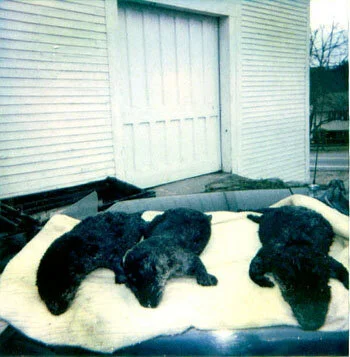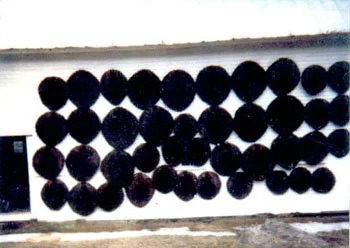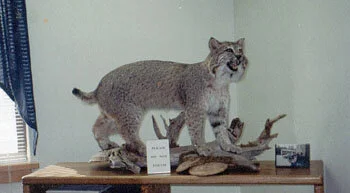Bill Swanson
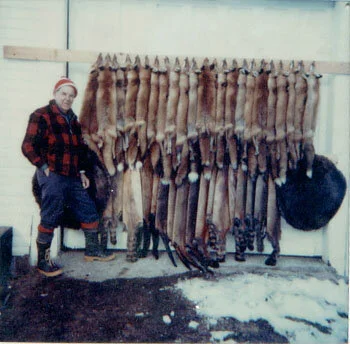
Inducted into the NHTA Hall of Fame in 2002.
The Goffstown Trapper: As told by Mel Liston
It was a beautiful spring day in late March 2005 when I stopped by the home of one of New Hampshire’s old trappers, Bill Swanson of Goffstown. Picture the cape style farmhouse with an attached white clapboard barn on an eight-acre homestead. I found Bill waiting with the sliding barn door open and taking in the warm bright sunshine while peeling an orange. So there we sat in two lawn chairs with a small table and a very few pictures to review his life as a trapper. Born in 1917 the man before me had trapped nearly as many of his years as I am old.
Bill’s earliest interest in trapping was sparked by the articles in Hunter-Trapper-Trader magazine. Living on the outskirts of Manchester New Hampshire offered little opportunity for a boy not yet into his teen years to know a real trapper. There was no one to bring the young boy along, and so this trapper would learn as a loner and always prefer his own company when tending traps.
Bill read trapping articles of the day, and visited the Merrimack River edge in search of sign. Eventually the young boy sent away to Sears and Roebuck for six-size #1 single long spring traps manufactured by Blake and Lamb. When the traps finally arrived Bill was anxious to get started with his first trapline along the Black Brook and swamp, a tributary into the Merrimack.
Starting about a mile outside the main part of the sprawling city, Bill push-polled a homemade raft through the swamp and marsh habitat all the way to the shadow of the industrial complex on the bank of the big river. Besides the young trapper, the raft also held his traps, bait, tools, and if lucky a catch of muskrat on the trip back home.
Self-motivated, the learning process had started with magazine articles and would be followed up with much trial and error. Growing success and continuing enthusiasm would hone the trapper’s skills for a lifetime of fur harvesting. The numbers of muskrat increased each season as Bill’s woodcraft and knowledge of the big wetland increased. The money received from the fur checks went toward the purchase of ever more traps and equipment. During the second fur season the first mink was added to the catch.
After a few years a big critter was taken, but young Bill was unsure what it might be. There was a neighbor named Geddes, who showed considerable interest in Bill’s trapping activities so he was presented with the mystery animal for identification. It turns out the critter was an otter. Bill and Mr. Geddes speculated that the otter might perhaps be worth a significant sum.
Geddes made a board to stretch the hide while young Bill began to count the chickens not yet hatched. They managed to get that otter hide away from the carcass and nailed to the board to dry. As soon as the oil was drawn out in the drying process and the hide turned to parchment, the single otter pelt was packaged for shipment and sent to F C Taylor in St Louis with the hope of quick money. The price quoted was way south of what Bill surmised as fair for such a rare catch, so he had it returned.
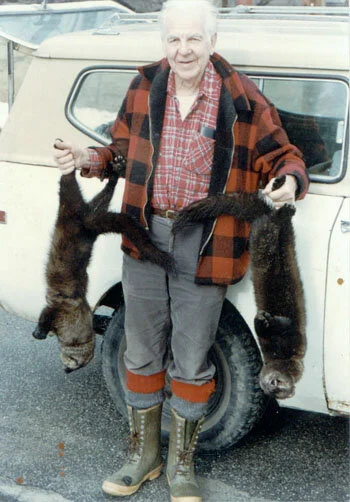
This time Bill shipped his otter to Sears and Roebuck, however the quote after inspection was lower still. “Darn” thought Bill “I was counting on a lot of money for that otter.”
More reading would apprise young Bill about the finer details in fur handling plus how not to singe the guard hair on an otter.
When Bill was fifteen his older brother built a small rowboat which he trusted him to utilize on his trapline. The small boat allowed much more access to additional habitat along the entire wetland area and the seasons catch performance improved. Bill’s trapping territory was limited to the big wetland habitat until a year out of High School when he managed to put his first automobile on the road. The trapline was producing a few mink each season and for less than the value of one mink, Bill obtained his first set of wheels. Fifteen dollars was all he paid for that first 1926 Chevrolet Sedan and with plates borrowed from a neighbors idle vehicle he was good to go.
Trapping from the old Chevy exposed the young trapper to a lot more territory for fur and presented his first significant opportunities to do some dry land trapping. There was a fox here and a fox there, but the bulk of the catch continued to be muskrat with an occasional mink or raccoon. Even though there was considerably more farming back then verses now, the coon numbers were down. Every struggling farmer put the welcome sign out for the coon hunters, and for many years the hounds’ men kept that problem animal under control.
As the human population became more urban, busy highways more common, and coon hide values declined, the reason and ability to harvest coon by hounds’ men was diminished. As the coon population occasionally expanded in the more congested areas, trappers like Bill would increasingly find them in their traps. In 1942 the war was on and every able-bodied man or boy was encouraged to try on a uniform.
Bill joined the army and would serve under General George Patton in France, Germany, and Austria. Before entering the service Bill married his sweetheart Marilynn Harriman. Early in the service of his country and before shipping out it was determined that Bill needed a hernia operation. While convalescing many soldiers were offered three day passes if they would buy a $25 war bond for $18.75. Bill made the investment and during the three-day leave his first of two sons was conceived.
The war finally ended and Bill returned to his wife, son, and the area he grew up in. The Leighton Machine Company of Manchester gave Bill a job in their machine shop. Bill worked for Leighton nine years and recalls that they always gave him a month off without pay during the trapping season allowing him an opportunity to make far more on his trapline in an era when fur had significant value. It was during the seasons trapped while employed at the machine shop that Bill came into his own as a land trapper, and started to have fine catches of red fox.
In 1955 Bill and family moved to California for business reasons, giving up the trapping for his new life out west. As time passed the dense population, traffic congestion, smog, and west coast life style became increasingly less attractive while the old life back east was beckoning both Bill and Marilynn to return. Return they did in 1958 with their two sons to a new job in Manchester as an Industrial Equipment Setup Mechanic and the house and barn on eight acres in Goffstown where they reside today. Bill did very little trapping during the remaining years of his career as he bided his time until retirement.
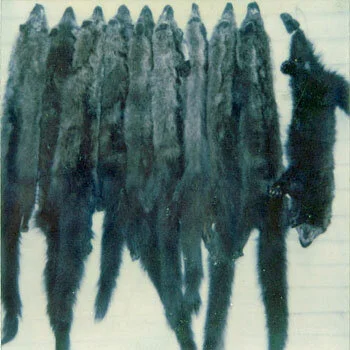
Once retired in 1980 at age 63 Bill jumped back into trapping as much as anyone could and still call it fun, yet Bill has always considered himself a hobby trapper. All legal furbearers were sought on the retirement trapline. The territory where Bill found permission to trap expanded to include Bedford, New Boston, Amherst, Goffstown, Dunbarton, and Weare. During this period Bill had his best red fox catch in 1990 with 50 and also over the years took three bobcats in fisher sets, which were all turned in to NHF&G. The most recent of those cats caught in 1998 was mounted and is on display at the Bow Police Station. The emphasis would continue to be a mixed bag trapline until more recent years when significant housing built up all around and free roaming dogs made land trapping less desirable. Bill finds himself once again focused on water animals except that instead of just muskrat and mink the game is beaver and otter now. Bill had always done all his own fur handling up until recently but now takes his coyote, excess beaver, and coon to Harris Ilsley for that service.
Bill joined the New Hampshire trappers Association when Bob Carlson was the president circa 1979-81. Bill has remained a member ever since and has been a Director for much of that period. In 2002 The New Hampshire Trappers Association inducted Bill Swanson into the Hall of Fame.
Like many of the older trappers, Bill remembers when fur had real value. In 1946 the trappers in Bill’s region were allowed five beaver each and he teamed up with a partner catching ten between them. They got $375 dollars for the ten beaver at a time when his job paid $1/hour. NHF&G required every beaver to be tagged back then at a cost to the trapper of $2 each, still the profit was substantial. Bill remembers stories from the old Hunter-Trapper-Trader magazine of 1916 hunters who would track fisher on the snow until treed with three such pelts being the price of a new automobile. He also remembers when bobcats were hunted with dogs for a $20 bounty yet the pelt was considered by the fur trade as nearly worthless. It is this memory that spans so many seasons that makes the old trapper’s story so valuable.
There is much to be learned from the memories of our oldest trappers still with us; they are testament to the history, which was theirs as they lived it.
